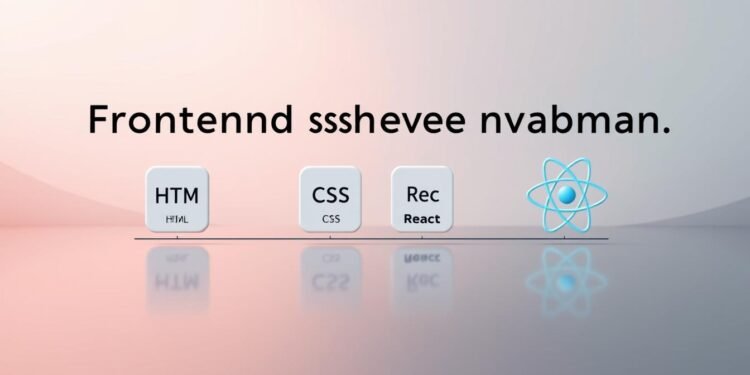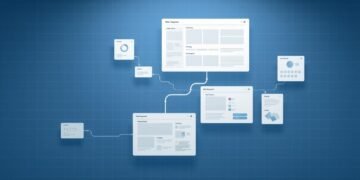Have you ever wondered what it takes to build the websites and apps we use every day? The answer lies in mastering the art of web development, where every click, scroll, and interaction is carefully crafted. With the digital world evolving rapidly, staying ahead requires a clear path to success.
In 2025, the focus is on building a dynamic skill set that adapts to industry demands. Starting with the basics of HTML and CSS, progressing to JavaScript, and finally mastering React, this roadmap ensures you’re ready for the challenges of modern web development. With over 386,000 students enrolled in Meta’s Front-End Developer Certificate program, the demand for these skills is undeniable.
Whether you’re starting a new career or upgrading your skills, this guide will help you navigate the essentials. From foundational knowledge to advanced techniques, you’ll discover how to meet employer requirements and create seamless user experiences.
Key Takeaways
- Front-end development is the foundation of modern web experiences.
- The 2025 roadmap emphasizes HTML/CSS and React mastery.
- Meta’s Front-End Developer Certificate has over 386,000 enrollments.
- Programs like Coursera offer discounts for career starters.
- Employers seek candidates with a strong grasp of core skills.
What is Frontend Development?
What powers the seamless experience you get on modern websites? The answer lies in front-end web development. This process focuses on building the user interface that appears on end-user devices. It’s all about creating the visual and interactive elements that make a website or application engaging and functional.
Key components include buttons, forms, media, and animations. These elements work together to ensure smooth navigation and responsiveness. For example, 91% of websites today use HTML5 for structuring content, ensuring compatibility across devices.
Front-end development handles the client-side of a website, meaning it directly impacts how users interact with the platform. Think of it like the dining area of a restaurant—what you see and experience. In contrast, back-end development is like the kitchen, where the behind-the-scenes work happens.
Modern advancements have expanded the scope of front-end development. Technologies like Progressive Web Apps (PWAs) and WebAssembly enable faster, more dynamic experiences. Additionally, Google’s Core Web Vitals set performance benchmarks, ensuring websites load quickly and run smoothly.
From responsive layouts to interactive features, front-end development is the backbone of every user-friendly website. It’s a constantly evolving field that blends creativity with technical expertise to deliver exceptional digital experiences.
Who is a Frontend Developer?
Behind every engaging website lies a professional who crafts its visual and interactive elements. These individuals are responsible for turning design concepts into functional, user-friendly interfaces. Their work ensures that websites are not only visually appealing but also responsive and efficient.

Key Responsibilities
A frontend developer’s daily tasks include translating Figma designs into functional code. They ensure cross-browser compatibility, making sure websites work seamlessly across different platforms. Tools like VS Code and Chrome DevTools are essential for debugging and optimizing performance.
Version control systems like Git and GitHub play a crucial role in managing projects. These tools help developers track changes, collaborate effectively, and maintain organized workflows. Additionally, mastering CSS frameworks like Flexbox and Grid is vital for creating responsive layouts.
Collaboration is another key aspect. Frontend developers work closely with UX designers to refine user experiences. They also coordinate with backend teams to integrate APIs and ensure smooth data flow. This teamwork is essential for delivering high-quality digital products.
The demand for these skills is growing rapidly, with a projected 13% job growth from 2020 to 2030. The average salary in the U.S. is $81,053, reflecting the value of these technologies in today’s market. Whether building interactive features or optimizing performance, frontend developers play a pivotal role in shaping the digital landscape.
Why Choose a Career in Frontend Development?
Are you looking for a dynamic and rewarding career in tech? The demand for skilled professionals in this field is skyrocketing. With 72% of businesses prioritizing their web presence, the need for experts who can create engaging user experiences has never been higher.
The tech industry offers endless opportunities for growth. From entry-level roles to senior positions, the income potential is impressive. Entry-level salaries start around $65,000, while experienced professionals can earn over $130,000 annually. This makes it a lucrative path for those willing to invest in their skills.
One of the key advantages of this career is vertical mobility. You can start as a junior developer and progress to roles like Tech Lead or UI Architect. This upward trajectory ensures long-term job satisfaction and financial stability.
Compared to backend development, frontend roles often involve more creativity. You’ll work on designing interfaces, animations, and interactive features that directly impact user experience. This blend of technical and creative challenges keeps the work exciting and fulfilling.
Continuous learning is another highlight. Frameworks and tools evolve rapidly, ensuring you’re always growing. Programs like Meta’s Front-End Developer Certificate provide interview prep and portfolio projects, helping you stand out to employers.
Success stories from Meta certificate alumni showcase the real-world impact of this career. Many have landed high-paying jobs and advanced their skills significantly. If you’re passionate about technology and creativity, this path offers a future full of possibilities.
Frontend Developer Roadmap: A Step-by-Step Guide
The journey to becoming a skilled professional in web development begins with a solid foundation. This step-by-step guide will help you navigate the essential skills and tools needed to succeed in this dynamic field.

1. Learn the Basics: HTML and CSS
Start with the fundamentals of HTML5 semantic markup and CSS custom properties. These are the building blocks of every website, ensuring proper structure and styling.
2. Master JavaScript for Interactivity
Next, dive into JavaScript to add interactivity to your projects. Focus on ES6+ features and async/await patterns to handle complex tasks efficiently.
3. Explore Responsive Web Design
Learn responsive design techniques like media queries and viewport meta tags. These ensure your websites look great on all devices, from desktops to smartphones.
4. Get Familiar with Version Control (Git)
Version control is essential for managing code. Master Git workflows, including feature branching and PR reviews, to collaborate effectively with teams.
5. Dive into Frontend Frameworks
Explore popular frameworks like React and Vue. With 86% of developers using React, it’s a must-learn for modern web development.
6. Advanced Topics: State Management and APIs
Understand state management tools like Redux Toolkit and Context API. Learn how to integrate APIs to fetch and display data dynamically.
7. Testing and Debugging Your Code
Ensure your code is reliable with testing strategies. Use Jest for unit tests and Cypress for end-to-end testing to catch errors early.
8. Build Real-World Projects
Apply your skills by creating projects like an e-commerce UI clone or a dashboard analytics tool. These will showcase your abilities to potential employers.
9. Stay Updated with Industry Trends
Keep learning by monitoring trends through GitHub Stars and State of JS reports. Staying updated ensures you remain competitive in the ever-evolving tech landscape.
Essential Soft Skills for Frontend Developers
Success in the tech industry isn’t just about technical expertise—it’s also about mastering soft skills. These abilities complement your coding knowledge and help you thrive in collaborative environments.
Effective communication is a game-changer. Whether presenting design handoffs to stakeholders or explaining complex ideas to non-technical teams, clarity is key. Studies show that 42% of developers credit strong communication as a career accelerator.
Collaboration is equally important. Tools like Jira and GitLab streamline Agile workflows, ensuring smooth project management. Open-source contributions also enhance teamwork, providing real-world experience in shared development environments.
Developing a problem-solving mindset is crucial. Debugging tools like browser DevTools help identify and fix issues efficiently. This skill ensures your projects run smoothly and meet user expectations.
Continuous learning keeps you ahead in this fast-paced field. Platforms like Egghead.io and CSS-Tricks offer valuable resources to stay updated. Meta’s programs even include technical interview prep, preparing you for real-world challenges.
By honing these soft skills, you’ll not only improve your technical abilities but also position yourself as a well-rounded professional in the tech industry.
Conclusion
Embarking on a career in web development offers endless opportunities for growth and creativity. Following a structured path—starting with HTML/CSS, mastering JavaScript, and advancing to React—ensures you’re well-prepared for industry demands. Whether you choose bootcamps or certifications like Meta’s program, focus on building a strong portfolio with 3-5 quality projects to showcase your skills.
Resources like freeCodeCamp and Frontend Masters can accelerate your learning. With the tech industry projected to grow by 13% by 2030, now is the perfect time to invest in your future. Meta’s capstone project, which creates a deployable web app, is an excellent way to gain hands-on experience.
Take the first step today. Enroll in Meta’s Front-End Developer Certificate and start building your dream career in web development.
FAQ
What is the first step to becoming a frontend developer?
Start by learning the basics of HTML and CSS. These are the core technologies for building the structure and style of websites. Once comfortable, move on to JavaScript for adding interactivity.
How long does it take to learn frontend development?
The time varies based on your dedication and prior experience. On average, it takes 3-6 months to grasp the fundamentals and 1-2 years to gain enough expertise for a professional role.
Do I need a degree to become a frontend developer?
No, a degree is not mandatory. Many developers succeed through online courses, self-study, and hands-on projects. Employers often value skills and a strong portfolio over formal education.
What are the most important skills for a frontend developer?
Key skills include proficiency in HTML, CSS, JavaScript, and frameworks like React. Additionally, understanding responsive design, version control, and debugging is crucial. Soft skills like problem-solving and communication are also essential.
What tools should I use as a beginner in frontend development?
Start with text editors like Visual Studio Code, browser developer tools, and Git for version control. As you progress, explore frameworks like React and libraries like Bootstrap.
How can I build a strong portfolio as a frontend developer?
Create real-world projects that showcase your skills. Include responsive websites, interactive applications, and examples of clean code. Share your work on platforms like GitHub or a personal website.
Is frontend development a good career choice?
Yes, it’s a rewarding career with high demand. The field offers opportunities to work on creative projects, solve user experience challenges, and stay updated with emerging technologies.
How do I stay updated with industry trends in frontend development?
Follow tech blogs, attend webinars, and join online communities like Stack Overflow or GitHub. Regularly practice new frameworks and tools to keep your skills relevant.
What are the challenges of being a frontend developer?
Challenges include keeping up with rapidly changing technologies, ensuring cross-browser compatibility, and optimizing website performance. Strong problem-solving skills and continuous learning are key to overcoming these.
Can I specialize in a specific area of frontend development?
Yes, you can specialize in areas like UI/UX design, accessibility, performance optimization, or frontend frameworks like React or Vue.js. Specialization can help you stand out in the industry.





